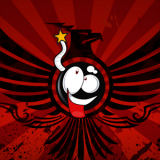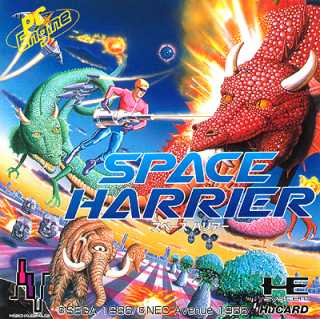Impressive VGM By Year: 1985
Rolling Blaster (MSX, LD) - Loud noise up until 0:24
Road Avenger/Road Blaster (ARC, LD)
Space Harrier (ARC, YM2203/OPN & SegaPCM)
Get ready! This is Sega's second attempt with FM synth after Hang-On and while the extra sampler chip (which was pretty advanced for the time) does handle both the drums and bass in most tracks, the use of the OPN chip is quite good and the overall result excellent for the time. In the ambitious main theme there's subtly modulated saw-like instruments, good use of harmony to get an almost chorus or flanger-like effect on the lead, and even some SSG/PSG is snuck in there. In Ida, FM and sampled bass are combined for a thicker, more aggressive sound, and most tracks in the OST use unique instruments for a more varied experience. My only criticism would be that the use of PSG could've been extended for a more fleshed out sound in most tracks, and so could the use of samples considering the 9+ channels and stereo support of the SegaPCM chip. While there are only two level themes, each boss has its own theme, making the OST fairly long and varied for the time.
Umi Yukaba (MSX, LD) - find hq, noise up until 1:57
Yie Ar Kung-Fu (C64)(Jean Michel Jarre - Magnetic Fields 4 cover)
Iconic to say the least. Various techniques that became C64/western chiptune staples were used here in the frantic, lengthy (near 6 minutes) and varied main theme: fast arpeggios, alternating bass and drums on one channel, ring modulation (and phaser modulation on the first solo lead?), chorused bass around the middle, decent noise drums, and a variety of lead timbres. Some or most of them for the first time. As good as it is though, that one theme is also all you're going to hear up until the ending.
Super Mario Bros. (NES),Remix,Inspirations(T-Square - Sister Marian (main theme), Piper - Summer Breeze (invincibility), Friendship - Let's Not Talk About It (underground))
Who hasn't heard this one? The main theme, which is Kondo's most famous track and the highlight of the OST, apparently took quite some time to finish and is pretty ambitious with four distinct parts to it, double harmony melodies and an unusual style landing somewhere between latin music, pop and reggae (though the main inspiration seems to have been a jazz fusion song). Somehow it perfectly fits the admittedly strange mix of themes that make up the SMB world though. There's a decent number of different songs here and while simpler, they're all above average for the time and system.
Looking at techniques used, there doesn't seem to be any variety in the square wave duty cycles anywhere in the soundtrack, but you do hear some envelope changes emulating piano- and string-like instruments here and there. The triangle wave, usually handling the bass is also used as a sort of flute in one or two tracks. It would've been nice to hear some echo, chorus or duty cycle modulation but this is still quite early in the system's lifespan.
Gradius (ARC, 2x AY-3-8910 & Proto-SCC/K005289)(added reverb),Alternate(added stereo)
The first use of what would become Konami's SCC chip used in MSX, and it's a good one (honestly I haven't heard a bad sounding SCC game). The chip allowedfor richer, warmer and somewhat more varied timbres that ends up sounding somewhere in-between Namco's WSG chip and the C64's SID chip. Compositionally Gradius is pretty distinct with its unusual scales and time signatures as well as its hectic and bouncy basslines. It's also a varied OST for the time with unique themes for each of its 7 levels. You can hear its influence on some other shoot 'em ups from later on, two examples being Truxton and Slap Fight MD.
The Last V8 (C64),Atari 8-bit ver.
Galivan: Cosmo Police/Cosmo Police Galivan (ARC, YM3526/OPL)
Considering the limited OPL1 chip used here, there's a pretty dynamic sound design with strong, relatively deep and varied percussion, echo effects on some leads as well as longer and more varied than average songs. Stylistically there are traits now associated with chiptunes such as slow arpeggios sometimes replacing chords, and odd slides and scales used here and there. It's also at least sort of in sync with the times, having some late 70s/early 80s hard rock-like tracks - this ends up suiting the game well.
The overall instrumentation here is a bit harsh, metallic and twangy besides the bass but it's kind of unfair to compare it to the more advanced YM2151 chip also in use at the time with its 4-op voices and various effects, or even the more similar OPL2/Adlib chip which had three additional waveforms built in. I think it compares pretty well to a lot of the later OPL2 output though, even from 5+ years later. There possibly could've been more modulation and detuning/chorus effects going on, which was now more or less standard in C64 games. There's also not many songs here, so there's some repetition even though the game is very short with repeating loops (short development time maybe?).
Looking at some specs and a channel breakdown in winamp we can see that the chip has a percussion mode with 5 dedicated (and I believe with pre-defined envelopes) percussion channels which is used here, and that 2 of the other 6 channels available when this percussion mode is used aren't used for the music, so there appears to be some missed potential in fleshing out the sound and making it more unique to the game. Being an early use of the chip, this and some other shortcomings are pretty forgivable though.
Alternate Reality: The City (Atari 8-bit)- Go to 3:30 to skip intro
Ultima IV (AII w/ mockingboard AY38910),Stereo,C64 ver. (1986)
While roughly equal to the prequel in terms of length and variety, some of the composition and sound design is more ambitious here, featuring echo and chorus on leads which is sometimes switched between lead and backing melody for the illusion of an extra channel (the chip also creates phaser-like effects on some notes, although this might've been unintentional). In Dungeon, multiple octaves are combined for a larger variety of timbres, vaguely resembling organ and harpsichord sounds. It seems they still hadn't figured out how to use the noise channel for percussion though.
Commando (C64),ARC ver. (2x OPN)
City Connection (ARC, AY38910+OPN)(Tchaikovsky, added reverb & stereo),Full OST
This game had 11 variations (one per level) on a 50s rock 'n roll style remix of a Tchaikovsky piece, with changes based on the country each level takes place in which is kinda cool in itself. Koji Kondo did a similar thing for Super Mario World's OST a few years later, except with bigger differences between most tracks. In terms of sound design, the FM synth work is hit and miss with some rather rough sounding patches for several tracks.
Notable for having different tracks for each level/mini-game segment, and its first theme's dreamy mood conjured up by a hypnotic chorused bassline and smooth arpeggios fading in and out, evolving into a classic C64-style bass/drum pattern where the snare fills in the "gap" in the former, and a catchy call and receive melody, with some cool drum fills from the middle onwards. In the fourth theme there are some other cool techniques used such as a modulated bass, arpeggiated attacks on the first lead, and combining a pulse wave and noise for more advanced drums (also heard in some early NES chip tracks such as Balloon Fight), all of which became staples in 8-bit chiptunes.
Way of the Exploding Fist (C64),In-Game Theme- re-find rip
Agent X (Spectrum, Beeper/Beeper w/ AY38910)
The ZX Spectrum's single channel PC Speaker (which is known as a buzzer or beeper) can simulate multiple channels by combining the waveforms of multiple instruments in memory into a single waveform and playing the output. That's how Follin is making what seems like multi-channel chiptunes on a single channel here. Besides that, these are long and varied tracks at over 3 minutes each which feature interesting techniques for the time such as echo effects, multiple timbres, rudimentary percussion and phaser effects. The one major downside to the beeper is the low resolution and harsh graininess of the sound, which you can't really do anything about it seems. In this upload, the AY-3 chip is used to add some relatively advanced percussion to the second song using three channels at once.
Choplifter (ARC, SN76496 at 4 MHz & 1 SN76496 at 2 MHz)
Ghosts 'n Goblins (ARC, 2x OPN),NES ver. (1986)
Terra Cresta (ARC, OPL),OPN ver. (SSG/PSG part only)
Metal Soldier Isaac II (ARC, 2x AY8910 & OkiMSM5232?)- Similar to Captain Neo from Darius and Basilisk Mine from Ninja Gaiden
Wizardry (C64)(the isometric adventure/rogue-like game),1996 Remix (C64)
Star Arthur Legend: Planet Mephius (MSX, LD) - find better footage, apparently usesVideo High Density (VHD) disc rather than LD
Tehkan World Cup (ARC, 2x AY8910 w/ OKIMSM5205)
The Legend of Kage (ARC, 2x OPN)(added reverb),X1 Turbo (YM2151, 1987)
Shadowfire (C64)(added stereo)
Galactic Warriors (ARC, 2x AY-3-8910 w/ K005289 or Sanyo VLM5030)
Teddy Boy Blues (ARC, 2x SN76496)(different)
I'm Sorry (ARC, 2x SN76496 at different clock speeds)
Teddy Boy (SMS)(jp ver. uses the arcade theme)
King's Quest II (PC, Tandy 3 Voice?)
Spy vs. Spy II (C64)(in-game),NES ver. (1987, in-game - find rip)

